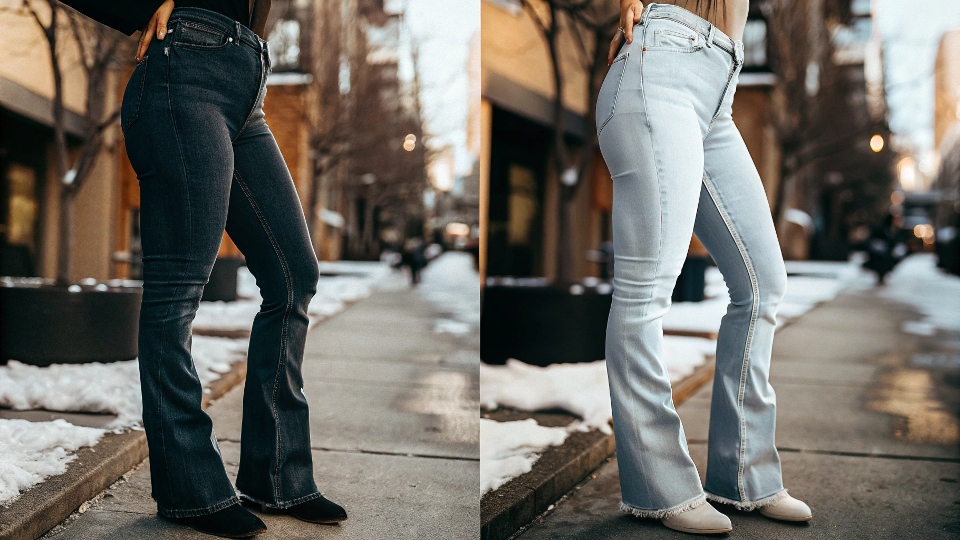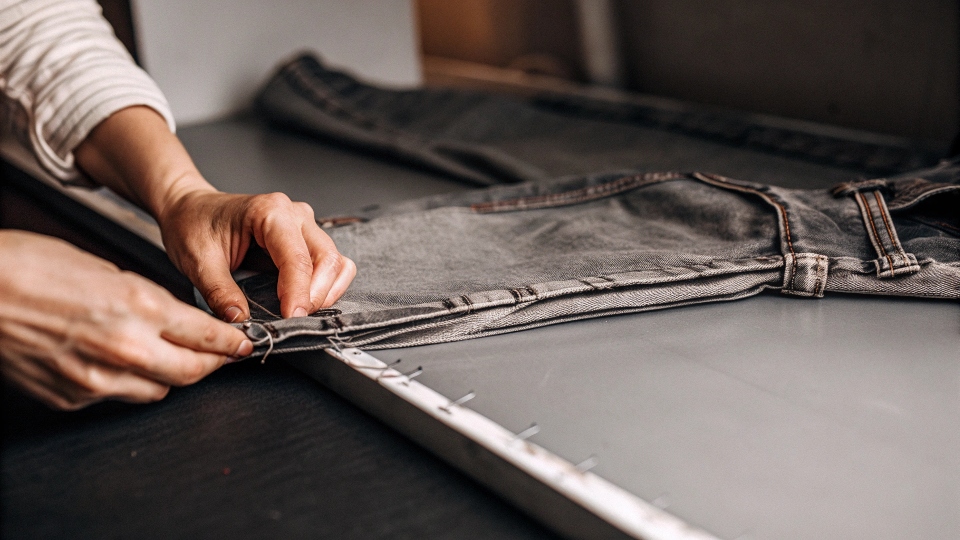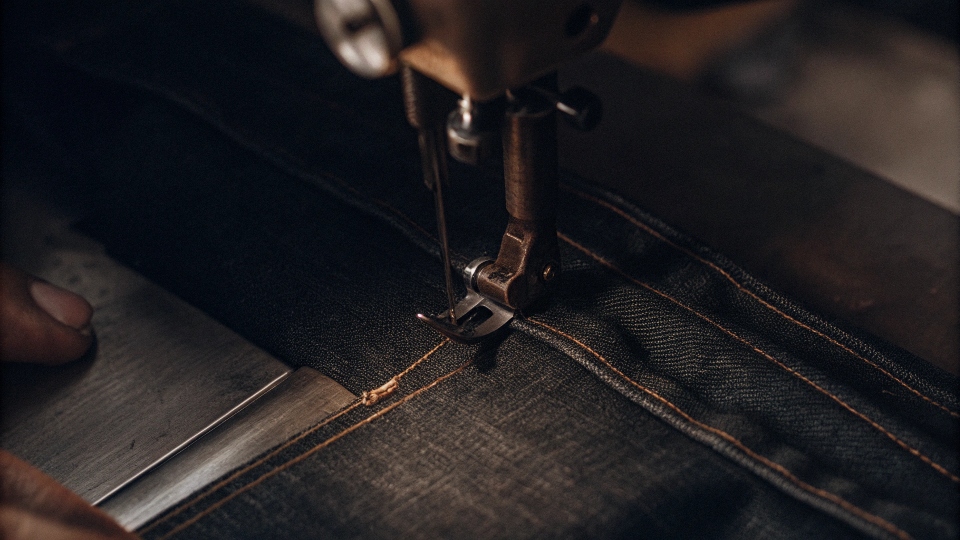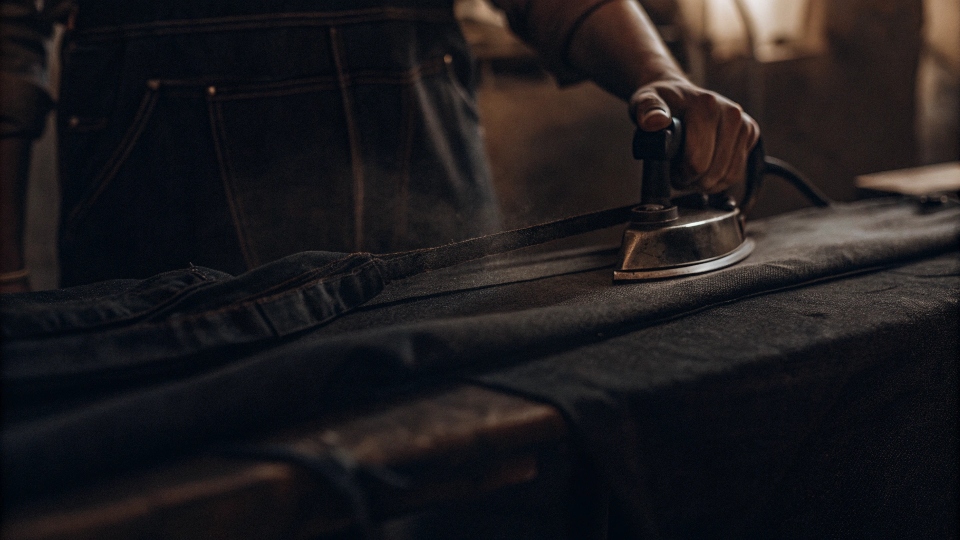You have a pair of straight-leg or bootcut jeans1 that you never wear. They feel outdated and don't fit your current style, but getting rid of them seems like a waste.
To make jeans skinny, turn them inside out, pin a new, tapered seam along the inseam2, and sew it with a machine. Then, you simply trim the excess fabric and turn them right-side out. This creates a custom-fit skinny jean from an old pair.
In my two decades running the DiZNEW denim factory, I've managed the production of every jean silhouette imaginable. The shift from bootcut to skinny jeans3 was one of the biggest changes the industry ever saw.
It required a complete rethinking of patterns and fabric, often incorporating more stretch. But the basic geometry of tapering a leg is a classic tailoring technique4.
Applying that same logic at home is a fantastic way to update your wardrobe and save a perfectly good pair of jeans from the back of the closet.
How to make your own skinny jeans?
You're ready to tailor your jeans but want a professional result. You're worried about sewing a crooked line or making them too tight, ruining the pair completely.
For a perfect fit, wear the jeans inside out and use pins to mark the new seam. Take them off, draw a smooth line with chalk connecting the pins, then sew directly on that line using a strong needle5 and thread.
This process is a simplified version of what we do when creating a new pattern. Getting the fit right is a hands-on process. Here's how to approach it methodically.
Step 1: Preparation and Pinning
First, put the jeans on inside out. This allows you to work directly on the seam allowance6s.
Stand in front of a mirror and begin pinching the excess fabric along the inseam, which is the seam that runs down the inner part of your leg. Use straight pins to secure the fabric.
Start at the mid-thigh, where you want the tapering to begin, and work your way down to the ankle. Make sure you can still slide the jeans off over your foot.
Step 2: Marking and Sewing
Once you're happy with the pinned fit, carefully take the jeans off. Lay them flat on a table, making sure the pinned seam is smooth.
Use a ruler and tailor's chalk to draw a straight, clean line connecting the pins. This will be your sewing guide. Set up your sewing machine with a heavy-duty or denim needle and strong thread—polyester is a good choice.
Sew slowly and carefully right on top of your chalk line, backstitching at the beginning and end to secure your new seam.
Step 3: Finishing the Seam
After sewing, try the jeans on (right-side out) one last time to check the fit. If it's perfect, it's time to finish the job.
Turn them inside out again and use sharp fabric scissors to trim the excess fabric, leaving about a half-inch seam allowance. To prevent fraying, you can sew a zigzag stitch along this new raw edge.
What does Gen Z think of skinny jeans?
You're about to put in the work to create a pair of skinny jeans. But you've heard they're "out of style," making you wonder if it's even worth the effort.
Gen Z largely rejected skinny jeans as the dominant fashion trend, favoring looser, more comfortable fits like baggy, straight, flare, and "mom" jeans. However, fashion is personal, and skinny jeans are now seen as a classic staple rather than a trend.
As a manufacturer, we see fashion trends in our order books long before they hit the stores. Starting around 2020, our orders for clients like Dean saw a massive shift.
Requests for skinny jean patterns dropped, while designs for '90s-style straight-leg and even wider baggy jeans shot up. Gen Z's preference is rooted in a desire for comfort and a more relaxed, gender-fluid silhouette.
They grew up when skinny jeans were the only option and, like any new generation, they wanted to define their own look. However, calling skinny jeans "dead" is an overstatement.
We still produce them, but they are no longer the number one best-seller. They've simply moved from being the trend to being a timeless basic, like a white t-shirt.
My advice is to wear what makes you feel good. If skinny jeans fit your body and your style, they are never the wrong choice.
Generational Jean Preferences
| Feature | Millennial Skinny Jeans | Gen Z Favorite Fits |
|---|---|---|
| Silhouette | Tight, form-fitting from hip to ankle. | Loose, relaxed, straight, or wide-leg. |
| Rise | Low to mid-rise was popular. | High-rise is overwhelmingly preferred. |
| Fabric | High-stretch content for a 'second skin' feel. | Often 100% cotton or rigid denim for structure. |
| Style Focus | Emphasizing the figure. | Comfort, function, and vintage-inspired look. |
Can you make jeans skinny?
You're holding a pair of classic, sturdy bootcut jeans made from 100% cotton. You're skeptical that such a stiff and structured garment can really be transformed into a sleek skinny fit.
Yes, you can absolutely make almost any pair of jeans skinny, including rigid non-stretch denim. The crucial technique is to taper the leg by creating a new seam only on the inseam, leaving the original outer seam completely untouched.
This is one of the most important rules in denim tailoring. The outer seam of a pair of jeans, or the outseam, is a key part of its identity and construction.
It often has detailed topstitching, and its straight line provides the foundational shape of the leg. Altering it is difficult and often looks messy. By contrast, the inseam is simple and plain.
Taking in all the excess fabric from the inseam allows you to create that tapered skinny shape without messing with the jean's core structure. The process works for both stretch and non-stretch denim, but you need to adjust your tools.
For rigid 100% cotton denim, you must use a strong denim needle (size 100/16 or 110/18) and high-quality thread.
For stretch denim, you should switch to a ballpoint or stretch needle to avoid skipping stitches and use a stretch stitch setting on your machine if you have one. This prevents the seams from popping when you move.
How to make skinny jeans skinnier without sewing?
You want a more tapered look, but you don't have a sewing machine or the confidence to sew through thick denim. You need a simple, no-sew hack to achieve the look quickly.
For a temporary no-sew fix, you can use heavy-duty fusible bonding web or fabric tape on the inside inseam. Apply the tape, fold the fabric over, and use a hot iron to create a new, slimmer seam.
This is a great trick for a quick adjustment or to test a new silhouette before making a permanent change. The process is very straightforward.
Start by turning your jeans inside out and putting them on to figure out how much you want to take them in. Pin it, then take them off and draw your new seam line with chalk, just as you would for sewing.
Then, cut a strip of strong, heat-activated fabric tape (like Peel'n Stick or Heat'n Bond). Place it just inside your chalk line. Fold the excess fabric over the tape, creating a clean new edge along your line. Press firmly with a hot iron according to the tape's instructions.
This melts the adhesive and bonds the fabric together. While this method is fast and easy, I have to say from a professional's perspective that it's not a permanent solution.
The bond may weaken with repeated washing. Another popular no-sew styling trick is "pin-rolling," where you tightly cuff the ankle to create a tapered look.
Conclusion
You can easily upcycle baggy jeans into a modern skinny fit. A simple sewing alteration along the inseam offers a permanent, professional result, while no-sew methods provide a quick, temporary fix.
-
Learn creative ways to repurpose bootcut jeans into trendy skinny jeans. ↩
-
Discover the importance of inseam measurement for achieving the right fit. ↩
-
Explore expert tips on altering skinny jeans for a perfect fit and style. ↩
-
Find out essential tailoring techniques to improve your denim alterations. ↩
-
Learn about the best needles for sewing thick denim and achieving durability. ↩
-
Understand the concept of seam allowance and its importance in garment making. ↩










